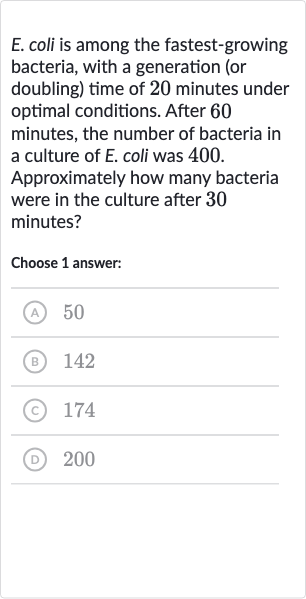AI tutor
Welcome to Bytelearn!
Let’s check out your problem:

E. coli is among the fastest-growing bacteria, with a generation (or doubling) time of minutes under optimal conditions. After minutes, the number of bacteria in a culture of . coli was . Approximately how many bacteria were in the culture after minutes?Choose answer:(A) (B) (C) (D)
Full solution
Q. E. coli is among the fastest-growing bacteria, with a generation (or doubling) time of minutes under optimal conditions. After minutes, the number of bacteria in a culture of . coli was . Approximately how many bacteria were in the culture after minutes?Choose answer:(A) (B) (C) (D)
- Understand the problem: Understand the problem.We know that E. coli bacteria double every minutes. After minutes, the culture has bacteria. We need to find out how many bacteria were present after minutes, which is one generation or doubling time before the count reached .
- Determine doublings in minutes: Determine the number of doublings that occurred in minutes.Since the doubling time is minutes, and we are looking at a -minute period, we can calculate the number of doublings by dividing by . minutes minutes per doubling doublings
- Find bacteria count after minutes: Work backwards to find the number of bacteria after minutes. Since the bacteria count is after minutes ( doublings), we need to divide by to find the count after doublings (which is minutes less). bacteria bacteria
More problems from Is (x, y) a solution to the system of equations?
QuestionGet tutor help
QuestionGet tutor help
